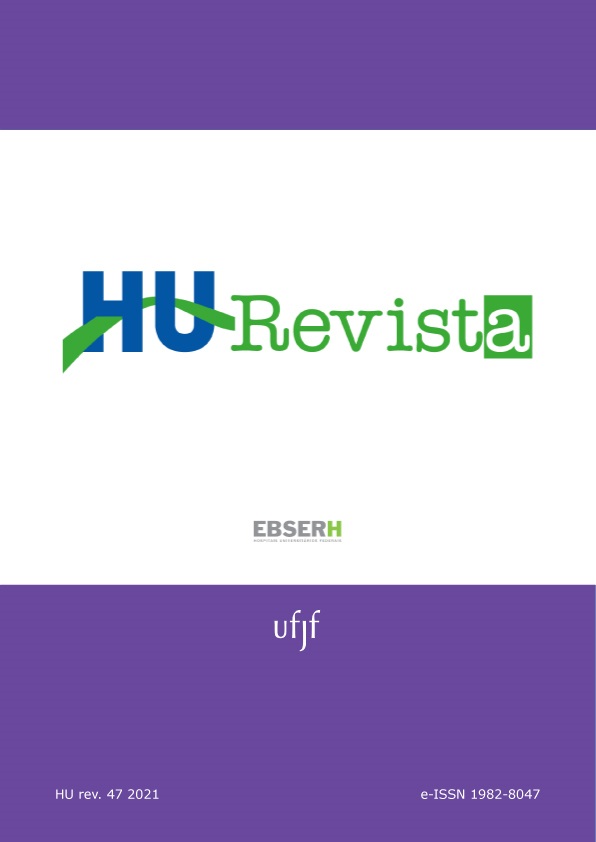Insonação à beira do leito: melhora na acurácia diagnóstica da anamnese e do exame físico pelo estudante de medicina
DOI:
https://doi.org/10.34019/1982-8047.2021.v47.33999Palabras clave:
Exame Físico, Ultrassonografia, Doença renalResumen
Introdução: A anamnese e o exame físico são considerados os pilares da avaliação clínica. Contudo, frequentemente, existe a necessidade da solicitação de exames complementares, particularmente os de imagem, para finalizar o processo diagnóstico. Nesse sentido, a utilização cada vez mais frequente dos dispositivos ultrassonográficos ultraportáteis, alguns com a incorporação de recurso de inteligência artificial, pode melhorar a precisão diagnóstica da anamnese e do exame físico tradicional durante a consulta médica. Objetivo: Relatar como a insonação à beira do leito permite ao estudante de medicina ampliar a obtenção de dados clínicos adicionais para uma tomada de decisão mais adequada quando do atendimento a um paciente com doença renal. Caso Clínico: Senhor de 49 anos foi encaminhado para avaliação nefrológica por quadro de edema em membros inferiores, astenia, episódio de hematúria macroscópica isolada, anúria e anasarca. No momento da consulta, encontrava-se assintomático. Relatou hipertensão arterial de longa data controlada com medicações anti-hipertensivas e cirurgia bariátrica prévia. Exame físico: Pressão arterial de 170x110 mmHg, ausculta cardiopulmonar nos limites da normalidade, cicatriz abdominal e edema em membros inferiores. Exames complementares trazidos pelo paciente evidenciavam doença renal crônica categoria 5, anemia, hipovitaminose D e proteinúria à urinálise. O eletrocardiograma evidenciou ritmo sinusal e sinais de sobrecarga de ventrículo esquerdo. A IBL realizada por estudantes de medicina após treinamento de duas horas sobre rins, coração, pulmão e veia cava inferior permitiu achados clínicos adicionais. Conclusão: A IBL permitiu identificar achados renais, abdominais, cardíacos e pleuropulmonares adicionais que permitiram uma tomada de decisão mais adequada quando do atendimento ao paciente.
Descargas
Citas
Kirch W, Schafii C. Misdiagnosis at a university hospital in 4 medical eras report on 400 cases. Medicine. 1996; 75:29-40.
Burton EC, Troxclair DA, Newman WP 3rd. Autopsy diagnoses of malignant neoplasms: how often are clinical diagnoses incorrect? JAMA. 1998; 280:1245-8.
Bordage G. Where are the history and the physical? CMAJ. 1995; 152:1595-8.
Bordage G. Why did I miss the diagnosis? Some cognitive explanations and educational implications. Acad Med. 1999; 74:S138-43.
Narula J, Chandrashekhar Y, Braunwald E. Time to add a fifth pillar to bedside physical examination: inspection, palpation, percussion, auscultation, and insonation. JAMA Cardiol. 2018; 3:346-50.
Rao S, van Holsbeeck L, Musial JL, Parker A, Bouffard JA, Bridge P et al. A pilot study of comprehensive ultrasound education at the Wayne State University School of Medicine: a pioneer year review. J Ultrasound Med. 2008; 27:745-9.
Fox JC, Chiem A, Rooney K, Maldonado. Web-based lectures, peer instruction and ultrasound-integrated medical education. Med Educ. 2012; 46:1109-10.
Hoppmann RA, Rao VV, Bell F et al. The evolution of an integrated ultrasound curriculum (iUSC) for medical students: 9-year experience. Crit Ultrasound J. 2015; 7:1-15.
Steinmetz P, Dobrescu O, Oleskevich S, Lewis J. Bedside ultrasound education in Canadian medical schools: a national survey. Can Med Edu J. 2016; 7:e78-8.
Bastos MG, Ronzani FAT, Carmo WB, Toledo GC, Paula RB. Integração do ensino da ultrassonografia point of care no currículo de graduação em medicina: um relato de experiência. HU Rev. 2019; 45:98-103.
Kobal SL, Trento L, Baharami S et al. Comparison of effectiveness of hand-carried ultrasound to bedside cardiovascular physical examination. Am J Cardiol. 2005; 96:1002-6.
Mouratev G, Howe D, Hoppmann R et al. Teaching medical students ultrasound to measure liver size: comparison with experienced clinicians using physical examination alone. Teach Learn Med. 2013; 25:84-8.
Olson APJ, Trappey B, Wagner M, Newman M, Nixon LJ, Schnobrich B. Point-of-care ultrasonography improves the diagnosis of splenomegaly in hospitalized patients. Crit Ultrasound J. 2015; 7:13.
Bastos MG, Vieira ALS, Pazeli Jr JM. Uso da ultrassonografia point-of-care na prática nefrológica: transpondo os limites do trato urinário. HU Rev. 2019; 45:341-51.
Koratala A, Teodorescu V, Niyyar VD. The nephrologist as an ultrasonographer. Adv Chronic Kidney Dis. 2020; 27:243-52.
Kimura B. Point-of-care cardiac ultrasound techniques in the physical examination: better at the bedside. Heart. 2017; 103:987-94.
Lang RM, Badano LP, Mor-Avi V et al. Recommendations for cardiac chamber quantification by echocardiography in adults: an up-date from the American Society of Echocardiography and the European Association of Cardiovascular Imaging. J Am Soc Echocardiogr. 2015; 28:1-39.e14.
Volpicelli G, Elbarbary M, Blaivas M et al. International evidence-based recommendations for point-of-care lung ultrasound. Intensive Care Med. 2012; 38:577-91.
Hubert A, Girerd N, Le Breton H et al. Diagnostic accuracy of lung ultrasound for identification of elevated left ventricular filling pressure. Int J Cardiol. 2019; 28:62-8.
Bastos MG, Vieira AL, Pazeli Jr JM, Galil AS. Diastolic dysfunction for nephrologists: diagnosis at the point of care. Rev Assoc Med Bras. 2020; 66:1750-6.
Descargas
Publicado
Cómo citar
Número
Sección
Licencia
Derechos de autor 2021 Paula Ribeiro Pena, Matheus Müller Martins, Geandra Martins de Freitas, Barbara Loures Peralva, Marcus Gomes Bastos

Esta obra está bajo una licencia internacional Creative Commons Atribución 4.0.
Cessão de Primeira Publicação à HU Revista
Os autores mantém todos os direitos autorais sobre a publicação, sem restrições, e concedem à HU Revista o direito de primeira publicação, com o trabalho licenciado sob a Licença Creative Commons Attribution que permite o compartilhamento irrestrito do trabalho, com reconhecimento da autoria e crédito pela citação de publicação inicial nesta revista, referenciando inclusive seu DOI.









